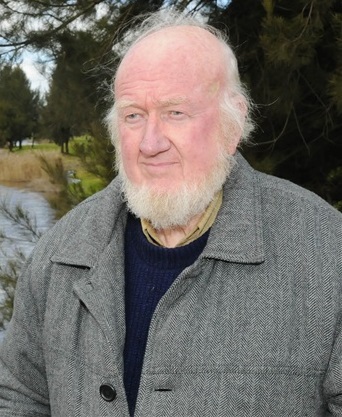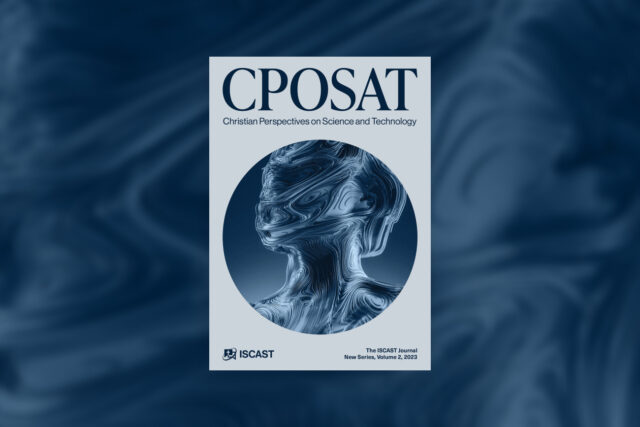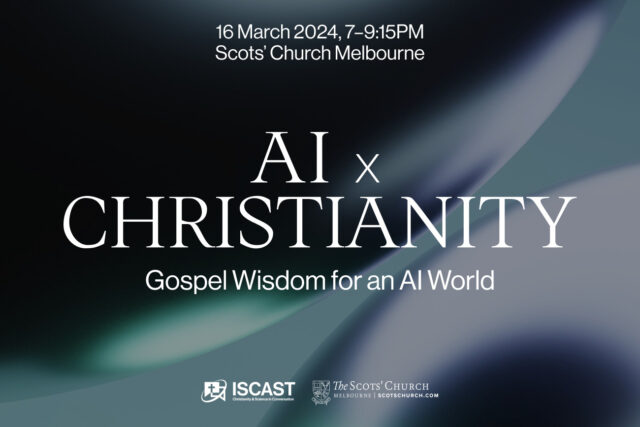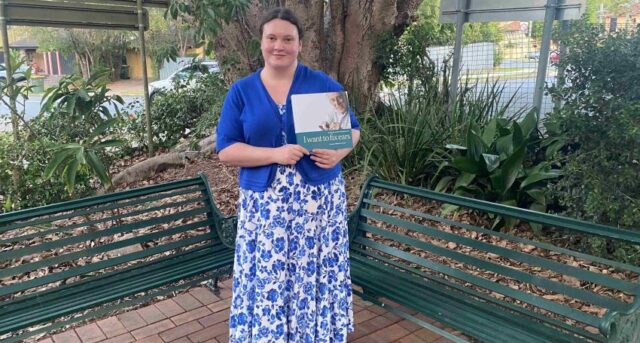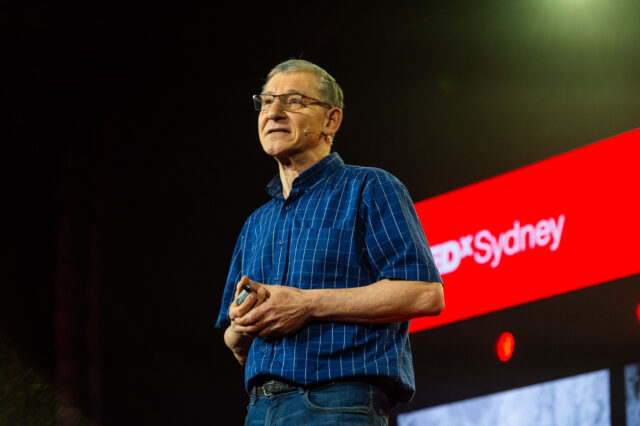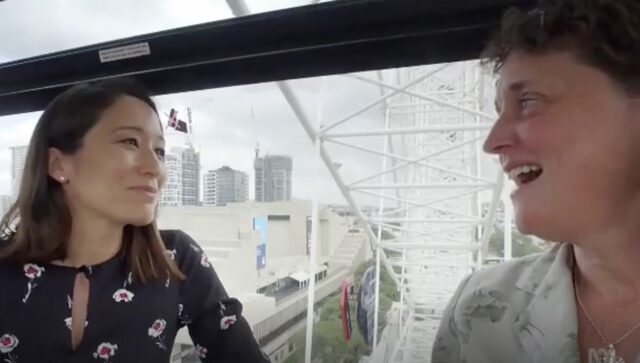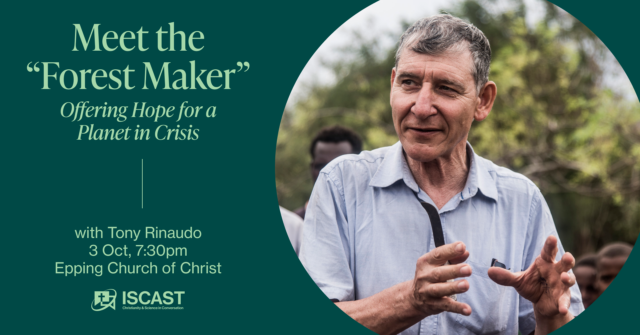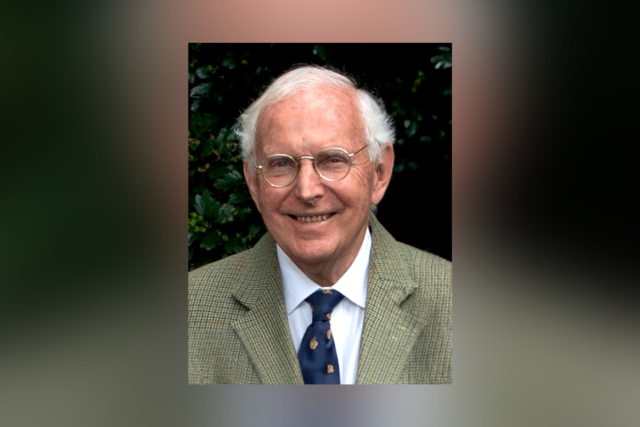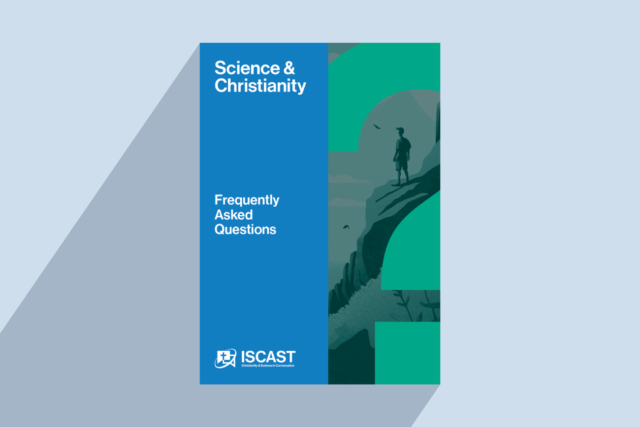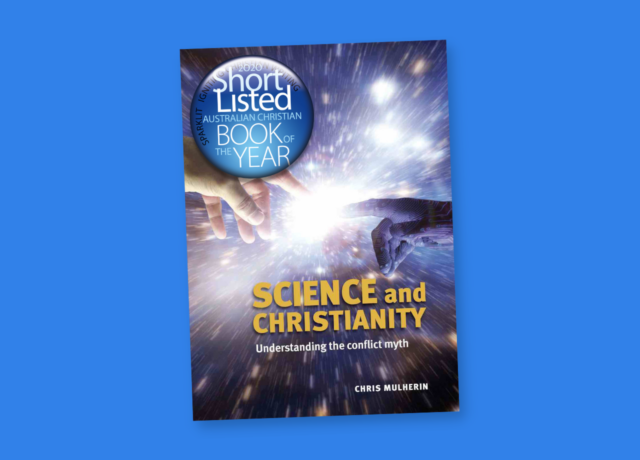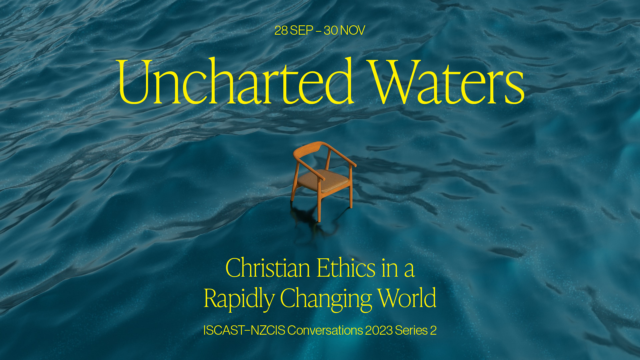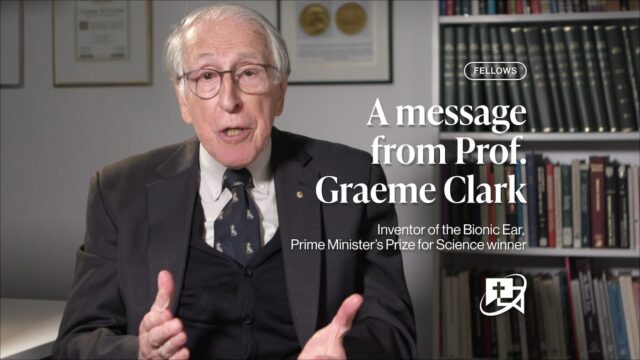

Bathurst ISCAST Fellow Professor David Goldney is directing some of his spare time in to speak about Christian faith and science with secondary students at local church schools.
Last year, he was guest speaker at All Saints College’s opening church service. David, directing his address to senior students, focused on Faith, Hope and Love. (The address is below and also in this PDF.) David related to students how faith is a leap of the human imagination seeking to ‘see’ reality from a novel perspective. David sought to draw parallels with how imagination is a defining tool used by scientists to create new patterns of understanding. Feedback from the chaplain, students staff and parents has been very positive. Subsequently the address was placed on the school website and used to promote discussion in religious studies lessons.
David also engaged with Bathurst Scots School year-12 students in two separate one-hour sessions taking the form of an interview with the school chaplain, a short talk followed by an open question time. On this occasion his talk was on the historical intertwining between Monotheism and the historical roots of modern science.
David enjoys a lively and honest exchange with students, most having no particular commitment to the Christian Faith. Both school chaplains indicated that about 3-10% of the student bodies are committed Christians. Both see it as a great opportunity to have visiting Christians with credible scientific backgrounds to speak with students in an open and honest manner. They see it as helping to dispel the myth of an ongoing warfare between science and Christian Faith. They also see it as an invaluable help to students from Christian homes who are struggling to bring mind and faith together in a compelling manner.
Reflecting on his school experiences with Chris Mulherin, Executive Director of ISCAST, Professor Goldney would like to encourage more Fellows and members to take up the challenge of speaking in schools about matters of science and faith. The door is usually wide open in Christian schools and with careful negotiation there are also significant opportunities within the state school system. In the latter case care needs to be taken to avoid any appearance of proselytising.
When asked to expand on what lessons and challenges might be learned from his recent experiences, David identified the following:
- Individual ISCAST chapters encourage Fellows and members to take up the school challenge as well as continuing with the set speaker strategy;
- Be prepared for left-field, brutally honest questions from students;
- Be well prepared;
- Take up Paul’s challenge to declare the ‘unknown God’ to thinking students.
Professor Goldney’s All Saints address, slightly modified, is below.
Faith, Hope and Love: The Greatest of These is Love
The following is an expanded version of an address given at the commencement service at All Saints School, Bathurst, by David Goldney on February 2, 2018.
David describes himself and the background to this address as follows:
I have lived in Bathurst with my wife Joan for 46 years, am still very much a Methodist at heart in the evangelical prophetic tradition. However, I worship regularly in the Anglican Cathedral where I find the sung Eucharist culturally appropriate. I am a semi-retired wildlife/landscape ecologist and an Adjunct Professor at Charles Sturt University. I remain very active in the community and even in my 80th year am still asked to speak to a range of groups in Bathurst as well as across the Central West of NSW, often about the relation between science and faith. I am currently writing two books, editing a conference proceedings and still undertaking limited research.
I was asked to speak at the commencement service at All Saints College in Bathurst focussing my address primarily towards teachers and teenagers. There were also kindergarten children present – they seemed to amuse themselves in interesting ways – perhaps something may have stuck – who knows? The brief from the chaplain was to get the students to think about faith issues.
Faith, Hope and Love: The Greatest of These is Love
I am a hard-nosed scientist, a wildlife ecologist, an academic given to rational thought and logic. I am also a committed Christian in the Evangelical [1]tradition. My Faith and my science are well integrated rather than being artificially kept in separate compartments. People often ask me How can you be a Christian and a scientist – aren’t they mutually exclusive? I am in good company with thousands of men and women scientists from nearly every nation on earth who share my Faith, from Nobel prize winners to the inventor of the Bionic Ear in Australia.
When the scientific revolution exploded in Christian Europe in the 17th C, Christians were at the forefront in facilitating this life changing movement. The scientific revolution was able to flourish in a Christian culture for many reasons including belief in four simple propositions:
(1) There is a Creator God who brings the universe into being;
(2) The Creation is Good;
(3) The Creator (God) is other than his creation; and
(4) The universe is ordered and its processes can be understood.
Christianity never embraced Pantheism.[2] Hence when the thunder rumbles and lightning strikes we can look for rational and natural explanations about these phenomena or any other happening for that matter, rather than see them as perhaps an expression of an angry god or even irrational magical processes. Aristotelian thinking (from 350 BC to around 1600) gave way to questioning and hypothesising, unleashing the power of experimental science.
When I was beginning my academic journey at the University of Adelaide in the late 1950s the prevailing scientific world view saw the universe as being in a steady state – unchanging – a view championed by the atheist astronomer Sir Fred Hoyle, since it appeared to do away with the notion of a Creation and therefore a Creator. The proposition was that the universe had always been there! It was the Belgium Catholic astronomer priest, Professor Georges Lemaitre who proposed a different model and bequeathed to us the notion of the Big Bang theory and the ever expanding universe the very antithesis of the Steady State theory. One of the arguments used by Hoyle to ridicule the Big Bang theory was that it would, if true, allow the Christian Genesis story some wriggle room. Indeed.
Let me introduce you briefly to one of the Fathers of the scientific revolution, a German Lutheran Christian born in 1646 – Gottfried Leibniz. He was a mathematician, philosopher, physicist and psychologist. He, along with Newton, independently invented calculus and the binary system at the heart of modern computing. He is regarded today as a genius. One of his legacies was to ask what is now agreed to be one of the great metaphysical questions of all time and one that none of us can escape asking –
Why is there something rather than nothing?
It is a deceptively simple but nevertheless a very profound and timeless question. Furthermore, as people living in the 21C we might also want to ponder on other questions such as: Do we live in a universe that is the product of blind chance or does it demonstrate purpose? Was there a ‘beginning’ and what was before the ‘beginning’? And is our planet in the Goldilocks Zone of the solar system, the result of a chance series of events or is this too consistent with a purposeful universe? Leibniz’s compelling question is with us in our waking and in our dying. Reflecting on his and other such questions provides us with clues that at least raise the possibility that there might just be a ‘god’ somewhere, a Ground of Being who brings all things into existence. Leibniz thought so.
A contemporary of Leibniz was another universal genius and fermenter of the Scientific Revolution, also a convinced Christian – Blaise Pascal. He proposed a Wager: God is, or He is not. But to which side shall we incline?
Is it heads or is it tails. In today’s parlance we think in terms of:
· atheism (there is no god),
· agnosticism (I do not know if there is or is not a god),
· theism (There is a God – a Ground of Being who is active in the world) or perhaps
· Deism (There is a god but he remains aloof from the world and having created it leaves it to its own devices.
Pascal also encourages us to explore the possibility of God communicating with us in multiple ways including through Word of God in Scripture and Word of God in Nature. I suspect that most of us at some stage in our life pilgrimage will of necessity consider atheism, agnosticism, theism or deism as our basis for living. I know that as a teenager I went through that harrowing but necessary process.
Johannes Kepler, a German Lutheran Christian born in 1571, the father of physical astronomy, first described his three laws of planetary motion, and in one fell swoop, took the study of the night sky from the superstitious fear that gripped the hearts and minds of the common people and scholars alike, to rational investigation, and in the process believed that he was thinking God’s thoughts after him.
Sir Isaac Newton, often thought of as the greatest scientist who has ever lived, also had a well-articulated Christian world view. He built on Kepler’s knowledge base to create his theory of universal gravity and the three laws of motion. Whilst understandably he had a very mechanical view of the solar system, he nevertheless saw God’s hand at work.
That brings me now to consider briefly the scripture reading we have just listened to from St Pauls letter to the Church in Corinth – And now these three remain: Faith, Hope and Love and the greatest of these is love.
Faith
The atheist astronomer the late Carl Sagan, a brilliant interpreter of the heavens, once said that Faith is believing in something in the absence of evidence. The atheist author of the God Delusion labels Christians as Faith-heads. I beg to differ – rather I see Christian Faith as a leap of the imagination[3] and never a leap based on absence of evidence. As the writer to the Hebrews puts it – Faith is the evidence of things not seen.
Let me explain. For hundreds of years people saw the stationary earth as the centre of the solar system until Copernicus came up with a revolutionary understanding that saw the sun as the centre of the solar system with the planets, including the earth, revolving around it. This was a brilliant leap of the imagination – he could not actually see his model he could only imagine it, and then test his understanding through making predictions – if you like ‘the evidence of things not seen’. This revolutionary understanding represented what scientists call a paradigm shift, seeing natural phenomena in a radically different way. Once we were blind to reality – now we see the world differently. Facts remain the same and are always available, but often make little sense unless we are able to connect the dots into a pattern of understanding – somewhat like looking at a random ink blot and suddenly realising that it is actually someone’s face – a Eureka moment.
The Eureka Moment for one-time atheist Professor C.S. Lewis who has enriched all of our lives with his children’s stories or through his other writings, occurred spontaneously as a passenger on the upper storey of a London double decker bus. There he met God – Ground of Being, or as he puts it in the title of his book– he was Surprised by Joy. The penny dropped after having been constantly followed by in his words, the Hound of Heaven. This was his leap of the imagination. Biblical writers often see this moment as ‘once I was blind, but now I see’ – what was previously just an ‘ink blot’ is transformed into looking at reality in a completely different way. Coming to Faith enables us to see reality differently and embrace a revolutionary world view. It does not usher in an era of logical certainty, that is not open to any of us – one reason why I find it difficult to understand the logic of atheism. Faith does however enable us to enter the world of psychological certainty.
Hope
We all hope for so many things, perhaps a better world, or maybe to make a lot of money, or perhaps to become Prime Minister or to do well in the HSC. There is nothing necessarily wrong with any of these hopes! Christian Hope is however somewhat differently nuanced. It draws its inspiration from the prophets and imagines a possible future (eschatology) where broken relationships are healed at multiple levels – between God and humans, individual brokenness, the breakdown in international order, and the broken relationship between humans and Nature. Scripture couches hope in the language of the Kingdom of God being amongst us and the vision of a New Heaven and Earth, where the wolf lies down with the lamb and where justice rolls down like an everlasting stream. The prophetic intent is to name evil and to work towards it eradication.
Let me give you two examples from my faith tradition. Some of my forebears were Bible Christians in Adelaide, one of the three major divisions of Methodism in colonial Australia that eventually merged to form the Methodist Church of Australia. It is now subsumed within the Uniting Church of Australia. Bible Christians in the 19thC encouraged women to be involved in ministry forbidden in most other denominations. Serena Thorne, a talented female Bible Christian evangelist, migrated to Adelaide around 1860 where she drew large crowds to hear her speak. She married Octavius lake a Bible Christian minister only after he promised to accept the right of women to be preachers, and to recognise the equality of women and men before God. Serena, now Serena Lake was a feminist and a leader of the Suffragette movement and helped bring the vote to South Australian women as well as their right to stand for parliament. She was also a leader in the temperance movement since it was male drunkenness that was the root cause of the epidemic of domestic violence in colonial Australia as well as in Great Britain. Serena’s husband Octavius, was my Father’s theology teacher and through him her feminist theology and practices were formative in his subsequent ministry.
In the little village of Tolpuddle in Dorset around 1834, John Loveless along with five other Methodist laymen formed a Union to seek better pay and conditions for farm labourers. It was likely that John was illiterate until he became a Christian during the period of Methodist revivals, and was taught to read and write in weekly Methodist Class meetings. Laypeople were also taught to lead meetings and to speak in public. John and his other union leaders were convicted of swearing a secret oath and sentenced to deportation to Australia as convicts in 1834, but due to a public outcry were eventually pardoned and returned to Dorset as freemen. They became known as the Tolpuddle Martyrs. Through their actions for justice they helped facilitate the formation of the British Labour Party.
Faith enables us to see reality from a novel perspective and Hope enables us as the Body of Christ to facilitate the healing of broken relationships and to seek justice in all the world. But are Faith and Hope enough?
Faith, Hope and Love – the greatest of these is Love
Thomas Merton, an influential Catholic Trappist monk, once claimed I believe in Nothing. In writing about his Cambridge University education, he says: I labored to enslave myself in the bonds of my own intolerable disgust. His conversion and Eureka moment is outlined in his biography- Seven Storey Mountain. Faith will open the door to a New Order, Hope will sensitise us to the universal cry for Justice, but it is Agape Love[4] that is at the heart of the Gospel, The Good News of the Jesus story. Merton reflecting on this writes To say that I am made in the image of God is to say that love is the reason for my existence, for God is love. Love is my true identity. Selflessness is my true self. Love is my true character. Love is my name.
‘God is love’ is the fundamental tenet of the Christian world view, God being expressed as Father, Son, and Spirit, not a mathematical formula, but rather humans struggling to understand the different ways that God reveals himself to us. Perhaps the best analogy that helps us understand this is to think about light that comes to us each moment as past, present and future, but still remains one light. The revolutionary Jesus story, God amongst us, comes to us with multiple paradoxes that can challenge our pre-conceived ideas of what life is all about. If you want to live life abundantly you must be prepared to lose your life. If you want to be in a relationship with Ultimate Reality, Ground of Being, God, and throb in sync with a universal agape Love you need to be prepared to die to self and to rise again as a person who now sees the world differently. That by the Grace of God is a paradigm shift that Christians call conversion and Jesus compared to being ‘Born Again’.
I wish you well in your life pilgrimage here at this moment at All Saints School. If you truly seek Truth you will surely find it and the Truth will make you free.
[1] The term Evangelical is entrenched within religious culture wars – I am referring specifically to the tradition that gave us William Wilberforce (abolishing slavery), the Tolpuddle Martyrs (6 Methodist Laymen transported to Australia for seeking fair wages for English workers), Serena Lake in South Australia – a leading figure in the Suffragette movement), Dietrich Bonhoeffer (stood against the Nazi Regime), Martin Luther King who led the USA Civil Rights movement in the 1970s), Nelson Mandela – the first Black President of South Africa, Archbishop Desmond Tutu who courageously stood against apartheid in South Africa, and atheist Professor C.S. Lewis, turned Christian – Christianity’s greatest apologist in the 20th C.
[2] Pantheism is the belief that all reality is identical with God – so a tree is part of God as is a rock, as is a human and a spider. Christians see God as Creator but other than his creation
[3] The writer to the Hebrews Chapter 11 put it this way – Faith is the evidence of things not seen, the substance of things hoped for….
[4] Agape Love is a sacrificial love that voluntarily suffers inconvenience, discomfort, and even death for the benefit of another without expecting anything in return.
